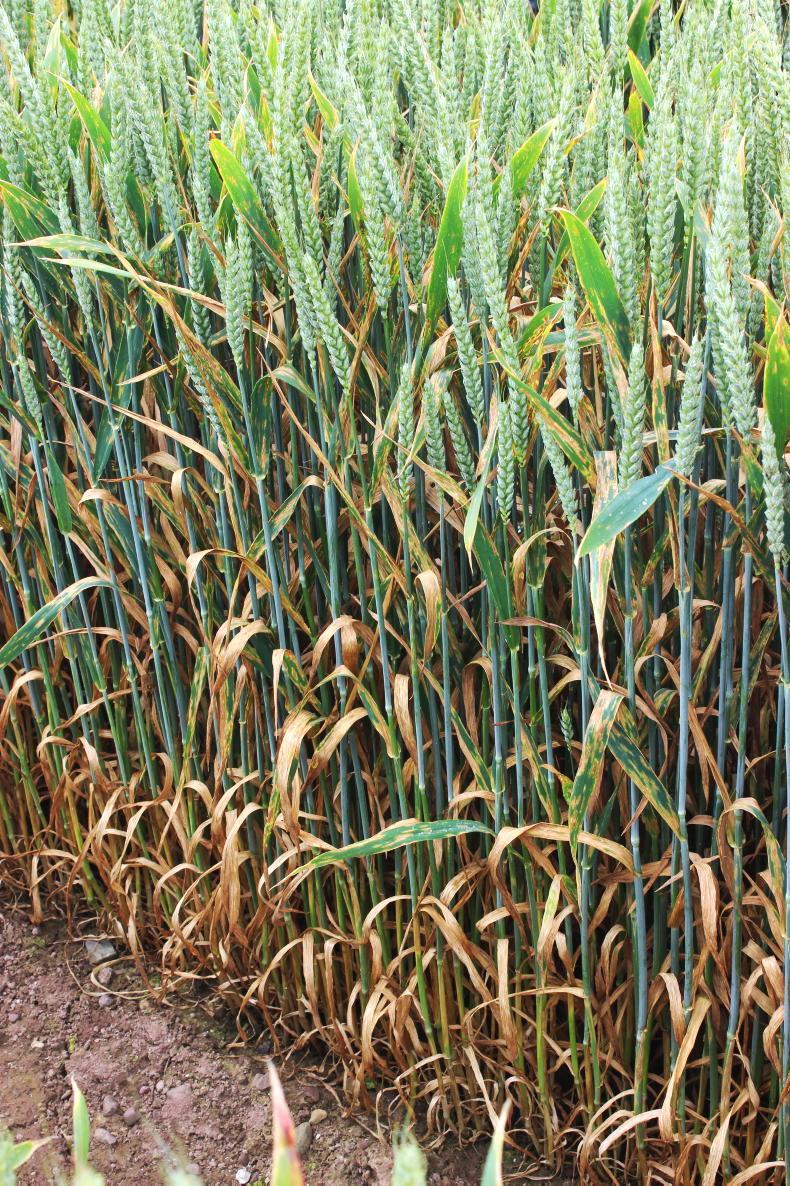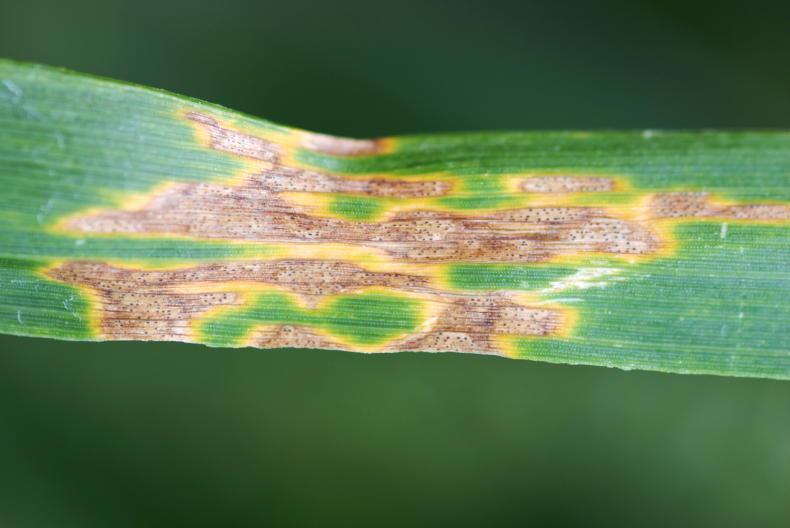For over three decades septoria tritici blotch has been the most damaging disease of Irish winter wheat crops.
The annual battle to combat it has over these decades resulted in the demise of some of the most novel fungicides developed, with resistance developing to key chemistries often only a few years after their commercial release.
In each instance fungicide resistance has developed almost without so much as an apparent dent in the disease. So what is it about septoria that makes it such a foe and is there really anything we can do about it?
In 2022 a team of researchers in Switzerland, France and the United Kingdom attempted to put a number on the amount of septoria spores that may be present in a hectare of winter wheat (see McDonald et al. 2022. Evolutionary Applications 15: 1360-1373). The number they came to was anything up to 9.9 trillion, or 9,900,000,000,000 spores. In simpler terms, a hell of a lot!
Individual strains
As a lot of these may well be clones and identical to each other the researchers dug further and estimated that this really looked more like up to 14 million unique or individual strains, each possibly with its own unique life traits.

Steven Kildea of Teagasc.
To some extent what they did can be regarded as an academic exercise; they acknowledged that the majority of spores produced will never actually go on to cause a new infection, being blown out of the field or landing on the soil for example.
What the research does do is highlight the unimaginable amount of genetic potential of septoria that exists in every hectare of wheat. The authors concluded that in a lot of the cases of fungicide resistance the emergence of mutated strains is most likely to have come from within local populations. Indeed, when we look at resistance to the SDHIs in Irish septoria populations we can see multiple instances where the same mutation emerges independently.
The development of a life trait such as fungicide resistance often results from simple genetic changes that happen by chance. Their selection, which ends up creating the problem that is fungicide resistance is also by chance – the mutated strain happening to occur during the narrow window during which fungicides are applied to the crop.
What is fungicide resistance?
With so much genetic potential in septoria populations is there really anything we can do to stop fungicide resistance developing in septoria and then spreading? Firstly, we have to remember what fungicide resistance actually is. It is the failure of the fungicide we apply to inhibit or restrict the growth of the pathogen or disease for which we are applying the fungicide. In the absence of the specific fungicide a resistant spore is just another spore competing against billions (or indeed trillions) of others for space on a wheat leaf to complete its life cycle.
What we do determines if the resistant strain has an advantage either on or in the wheat leaf over those other spores it is competing against. The old adage that if we didn’t use fungicides we wouldn’t have fungicide resistance comes to mind, but being honest, in our climate if we didn’t use fungicides in wheat we probably wouldn’t be growing wheat so that is a bit of a moot debate.

Septoria has continued to evolve and develop to overcome the impact of different families of fungicides.
Understanding that what we do when we apply fungicides directs the evolution of the pathogen or disease should influence how we devise disease control programmes.
How do we prevent resistance?
In fungicide anti-resistance management our aim is to reduce the chances a mutant strain has of surviving and thriving above those other fungicide sensitive strains it must compete against for space and resources. Granted, as the objective of applying fungicides is to protect the crop from disease irrespective of their sensitivity to fungicides, we don’t actually want to sacrifice disease control, so we equally don’t want those sensitive strains to thrive either. This is a fine balancing act.
As the advantage a fungicide resistant strain has is relative to the inhibition or restriction a fungicide places upon the sensitive strains, limiting this to as short a period as is absolutely necessary will slow down the selection for resistance.
This can be achieved by multiple different means:
Ensuring fungicides are only applied when absolutely necessary.Ensuring fungicides are only applied at doses or rates that are absolutely necessary to achieve the required level of disease control – for most fungal diseases, including septoria, the belief that reducing fungicide rates increases fungicide resistance is actually wrong. Increased dose drives selection for all the reasons described above (it is different for herbicides and we shouldn’t confuse the two).Alternating between different modes of action if possible reduces the amount of time a pathogen or disease population is exposed to an individual fungicide mode of action. While alternating different fungicide modes of action will reduce exposure times, if applied alone there exists a period where selection can occur before the next alternate fungicide is applied. It stands to reason that one of the most successful means of managing fungicide resistance is to mix different fungicide modes of action that have equal or as close to as possible equal levels of efficacy.
If a strain by chance emerges with resistance to one of the fungicides in the mix, the other in theory will restrict its development and it will have no advantage over the other spores splashing around the crop. Mixing of different fungicide modes of action is now the cornerstone of fungicide resistance management.

Isolates of septoria tritica have been found that are less sensitive to SDHI fungicides.
Finally, as managing fungicide resistance is really a numbers game or a game of chance, reducing the overall numbers (i.e. disease) by alternative means will help reduce the chances of a mutated strain arising when a fungicide is being applied. It is inevitable that some amount of septoria will arise in a winter wheat crop. However, managing the crop to reduce the overall amount of disease not only reduces the disease burden and potential impact on yield, it reduces the chances of the resistance strain being present when fungicides are applied, and the intensity of fungicides required and hence duration during which that resistance strain will have an advantage. If we could knock a zero off the end of that stupidly high number of spores in a field it really would dent the armour of septoria.
For over three decades septoria tritici blotch has been the most damaging disease of Irish winter wheat crops.
The annual battle to combat it has over these decades resulted in the demise of some of the most novel fungicides developed, with resistance developing to key chemistries often only a few years after their commercial release.
In each instance fungicide resistance has developed almost without so much as an apparent dent in the disease. So what is it about septoria that makes it such a foe and is there really anything we can do about it?
In 2022 a team of researchers in Switzerland, France and the United Kingdom attempted to put a number on the amount of septoria spores that may be present in a hectare of winter wheat (see McDonald et al. 2022. Evolutionary Applications 15: 1360-1373). The number they came to was anything up to 9.9 trillion, or 9,900,000,000,000 spores. In simpler terms, a hell of a lot!
Individual strains
As a lot of these may well be clones and identical to each other the researchers dug further and estimated that this really looked more like up to 14 million unique or individual strains, each possibly with its own unique life traits.

Steven Kildea of Teagasc.
To some extent what they did can be regarded as an academic exercise; they acknowledged that the majority of spores produced will never actually go on to cause a new infection, being blown out of the field or landing on the soil for example.
What the research does do is highlight the unimaginable amount of genetic potential of septoria that exists in every hectare of wheat. The authors concluded that in a lot of the cases of fungicide resistance the emergence of mutated strains is most likely to have come from within local populations. Indeed, when we look at resistance to the SDHIs in Irish septoria populations we can see multiple instances where the same mutation emerges independently.
The development of a life trait such as fungicide resistance often results from simple genetic changes that happen by chance. Their selection, which ends up creating the problem that is fungicide resistance is also by chance – the mutated strain happening to occur during the narrow window during which fungicides are applied to the crop.
What is fungicide resistance?
With so much genetic potential in septoria populations is there really anything we can do to stop fungicide resistance developing in septoria and then spreading? Firstly, we have to remember what fungicide resistance actually is. It is the failure of the fungicide we apply to inhibit or restrict the growth of the pathogen or disease for which we are applying the fungicide. In the absence of the specific fungicide a resistant spore is just another spore competing against billions (or indeed trillions) of others for space on a wheat leaf to complete its life cycle.
What we do determines if the resistant strain has an advantage either on or in the wheat leaf over those other spores it is competing against. The old adage that if we didn’t use fungicides we wouldn’t have fungicide resistance comes to mind, but being honest, in our climate if we didn’t use fungicides in wheat we probably wouldn’t be growing wheat so that is a bit of a moot debate.

Septoria has continued to evolve and develop to overcome the impact of different families of fungicides.
Understanding that what we do when we apply fungicides directs the evolution of the pathogen or disease should influence how we devise disease control programmes.
How do we prevent resistance?
In fungicide anti-resistance management our aim is to reduce the chances a mutant strain has of surviving and thriving above those other fungicide sensitive strains it must compete against for space and resources. Granted, as the objective of applying fungicides is to protect the crop from disease irrespective of their sensitivity to fungicides, we don’t actually want to sacrifice disease control, so we equally don’t want those sensitive strains to thrive either. This is a fine balancing act.
As the advantage a fungicide resistant strain has is relative to the inhibition or restriction a fungicide places upon the sensitive strains, limiting this to as short a period as is absolutely necessary will slow down the selection for resistance.
This can be achieved by multiple different means:
Ensuring fungicides are only applied when absolutely necessary.Ensuring fungicides are only applied at doses or rates that are absolutely necessary to achieve the required level of disease control – for most fungal diseases, including septoria, the belief that reducing fungicide rates increases fungicide resistance is actually wrong. Increased dose drives selection for all the reasons described above (it is different for herbicides and we shouldn’t confuse the two).Alternating between different modes of action if possible reduces the amount of time a pathogen or disease population is exposed to an individual fungicide mode of action. While alternating different fungicide modes of action will reduce exposure times, if applied alone there exists a period where selection can occur before the next alternate fungicide is applied. It stands to reason that one of the most successful means of managing fungicide resistance is to mix different fungicide modes of action that have equal or as close to as possible equal levels of efficacy.
If a strain by chance emerges with resistance to one of the fungicides in the mix, the other in theory will restrict its development and it will have no advantage over the other spores splashing around the crop. Mixing of different fungicide modes of action is now the cornerstone of fungicide resistance management.

Isolates of septoria tritica have been found that are less sensitive to SDHI fungicides.
Finally, as managing fungicide resistance is really a numbers game or a game of chance, reducing the overall numbers (i.e. disease) by alternative means will help reduce the chances of a mutated strain arising when a fungicide is being applied. It is inevitable that some amount of septoria will arise in a winter wheat crop. However, managing the crop to reduce the overall amount of disease not only reduces the disease burden and potential impact on yield, it reduces the chances of the resistance strain being present when fungicides are applied, and the intensity of fungicides required and hence duration during which that resistance strain will have an advantage. If we could knock a zero off the end of that stupidly high number of spores in a field it really would dent the armour of septoria.









 This is a subscriber-only article
This is a subscriber-only article











SHARING OPTIONS: